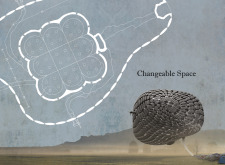5 key facts about this project
The design presents a detailed exploration of flexibility in space under the concept of "Changeable Space." Located in a large urban setting, it accommodates around 2000 visitors in a central room designed for dynamic performances. The overall concept focuses on interaction and adaptability, allowing users to experience a unique relationship with the environment and its features.
THEMES OF ELEVATION AND INTERACTION
Central to the design is the theme of elevation, which uses helium to create a buoyant atmosphere. By allowing objects to rise and move, this application enhances the interactions within the space. Performers engage with the environment in new ways, redefining the traditional roles of audience and artist. The sight of bubbles emerging toward the stage complements the performance and creates an intriguing visual experience for guests.
STRUCTURAL INNOVATION
Integrity in the structure is achieved through a double-shell construction method. A space of about 30 meters exists between the two shells, filled with helium to provide insulation and acoustic benefits. The walls and facades are composed of a two-meter thick layer of metal foam, ensuring that the internal environment remains comfortable and inviting, regardless of external changes. This choice of materials plays a significant role in regulating temperature and sound.
MATERIAL SELECTION AND FUNCTIONALITY
Caoutchouc is included for its elastic qualities, enabling the structure to adapt to shifting conditions. An outer layer of caoutchouc foil further enhances the flexibility of the design while reinforcing the integrity of the helium-filled chamber. These material choices address practical needs while also contributing to the visual character of the space.
INTERACTION WITH THE ENVIRONMENT
The design engages with the audience, fostering a dialogue that enriches the overall experience. Performers ascend as the floor rises beneath them, creating a captivating spectacle for those watching. The combination of performance and architectural elements offers a fresh perspective on public spaces, showing how modern design can encourage new forms of interaction. The result is a setting where the movement of both space and its users creates a lively backdrop for artistic expression.






















































